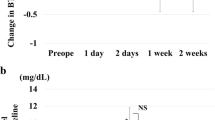Abstract
The aim of this study is to investigate the influences of the anti-tumour necrosis factor (TNF) agents infliximab and etanercept on the postoperative recovery of patients with rheumatoid arthritis (RA). We also investigated the effects of biologics on wound healing. Patients with RA were split into a TNF group (n = 39) that underwent 39 operations and were treated with anti-TNF agents, and a non-TNF group (n = 74) that underwent 74 operations and were treated only with conventional disease-modifying antirheumatic drugs. Operations included ankle arthrodesis and total arthroplasty of the hip, knee, elbow, shoulder and ankle. Adverse events (AEs) of surgical wounds, time for complete wound healing, febrile period after operation and recovery parameters after operation (%recovery of haemoglobin (Hb), total protein and albumin at 4 weeks after operation compared with pre-operation levels) were investigated. AEs of surgical wounds occurred in two operations (5.1%) in the TNF group and in five operations (6.8%) in the non-TNF group, but this difference was not statistically significant. There were also no significant differences in the time for complete wound healing and in the length of the febrile period between the two groups. Percentage recovery of Hb was significantly better in the TNF group than in the non-TNF group (96.3% vs. 90.1%, respectively; p < 0.05). These results suggest that the use of anti-TNF agents does not cause specific AEs on surgical wounds after elective orthopaedic operations in RA patients and might improve the percentage recovery of Hb due to its prompt anti-TNF effects.


Similar content being viewed by others
References
Maini R, St Clair EW, Breedveld F, Furst D, Kalden J, Weisman M et al (1999) Infliximab (chimeric anti-tumor necrosis factor alpha monoclonal antibody) versus placebo in rheumatoid arthritis patients receiving concomitant methotorexate: a randomized phase III trial. Lancet 354:1932–1939
Weinblatt ME, Kremer JM, Bankhurst AD, Bulpitt KJ, Fleischmann RM, Fox RI et al (1999) A trial of etanercept, a recombinant human tumor necrosis factor: Fc fusion protein in patients with rheumatoid arthritis receiving methotrexate. N Eng J Med 340:253–259
Choy EH, Panayi GS (2001) Cytokine pathways and joint inflammation in rheumatoid arthritis. N Engl J Med 344:907–916
Mooney DP, O’Reilly M, Gamelli RL (1990) Tumor necrosis factor and wound healing. Ann Surg 211:124–129
Salomon GD, Kasid A, Cromack DT, Director E, Talbot TL, Sank A et al (1991) The local effects of cachectin/tumor necrosis factor on wound healing. Ann Surg 214:175–180
Mori R, Kondo T, Ohshima T, Ishida Y, Mukaida N (2002) Accelerated wound healing in tumor necrosis factor receptor p55-deficient mice with reduced leukocyte infiltration. FASEB J 16:963–974
Takashima K, Tateda K, Matsumoto T, Iizawa Y, Nakao M, Yamaguchi K (1997) Role of tumor necrosis factor alpha in pathogenesis of pneumonia in mice. Infect Innun 65:257–260
Rothe J, Lesslauer W, Lotcher H, Lang Y, Koebel P, Kontgen F (1993) Mice lacking the tumor necrosis factor receptor 1 are resistant to TNF-mediated toxicity but highly susceptible to infection by Listeria monocytegenes. Nature 364:798–802
Tite JP, Dougan G, Chatfield SN (1991) The involvement of tumor necrosis factor in immunity to Salmonella infection. J Immunol 147:3161–3164
Seo SH, Webster RG (2002) Tumor necrosis factor alpha exerts powerful anti-influenza virus effects in lung epithelial cells. J Virol 76:1071–1076
Furst DE, Wallis R, Broder M, Beenhouwer DO (2006) Tumor necrosis factor antagonists: different kinetics and/or mechanisms of action may explain differences in the risk for developing granulomatous infection. Semin Arthritis Rheum 36:159–167
den Broeder AA, Creemers MCW, Fransen J, de Jong E, de Rooij DR, Wymenga A et al (2007) Risk factors for surgical site infections and other complications in elective surgery in patients with rheumatoid arthritis with special attention for anti-tumor necrosis factor: a large retrospective study. J Rheumatol 34:689–695
Means RT Jr (2003) Recent development in the anemia of chronic disease. Curr Hematol Rep 2:116–121
Jongen-Lavrencic M, Peeters HR, Wognum A, Vreugdenhil G, Breedveld FC, Swaak AJ (1997) Elevated levels of inflammatory cytokines in bone marrow of patients with rheumatoid arthritis and anemia of chronic disease. J Rheumatol 24:1504–1509
Papadaki HA, Krikikos HD, Valatas V, Boumpas DT, Eliopoulos GD (2002) Anemia of chronic disease in rheumatoid arthritis is associated with increased apoptosis of bone marrow erythroid cells: improving following anti-tumor necrosis factor-alpha antibody therapy. Blood 100:474–482
Saag KG, Teng GG, Patkar NM, Anuntiyo J, Finney C, Curtis JR et al (2008) American college of rheumatology 2008 recommendations for the use of nonbiologic and biologic disease-modifying antirheumatic drugs in rheumatoid arthritis. Arthritis Rheum 15:762–784
Koike R, Takeuchi T, Eguchi K, Miyasaka N (2007) Update on the Japanese guidelines for the use of infliximab and etanercept in rheumatoid arthritis. Mod Rheumatol 17:451–458
Talwalkar SC, Grennan DM, Gray J, Johnson P, Hayton MJ (2005) Tumor necrosis factorα antagonists and early postoperative complications in patients with inflammatory joint disease undergoing elective orthopaedic surgery. Ann Rheum Dis 64:650–651
Bibbo C, Goldberg JW (2004) Infectious and healing complications after elective orthopaedic foot and ankle surgery during tumor necrosis factor-alpha inhibition therapy. Foot Ankle Int 25:331–335
Wendling D, Balblanc JC, Brousse A, Lohse A, Lehuede G, Garbuio P et al (2005) Surgery in patients receiving anti-tumour necrosis factor alpha treatment in rheumatoid arthritis: an observational study on 50 surgical procedures. Ann Rheum Dis 64:1378–1379
Giles JT, Bartlett SJ, Gelber AC, Nanda S, Fontaine K, Ruffing V et al (2006) Tumor necrosis factor inhibitor therapy and risk of serious postoperative orthopedic infection in rheumatoid arthritis. Arthritis Rheum 55:333–337
Acknowledgement
This work was funded by the Aichi D.R.G. Foundation, Aichi, Japan.
Disclosures
None
Author information
Authors and Affiliations
Corresponding author
Rights and permissions
About this article
Cite this article
Hirano, Y., Kojima, T., Kanayama, Y. et al. Influences of anti-tumour necrosis factor agents on postoperative recovery in patients with rheumatoid arthritis. Clin Rheumatol 29, 495–500 (2010). https://doi.org/10.1007/s10067-009-1346-1
Received:
Revised:
Accepted:
Published:
Issue Date:
DOI: https://doi.org/10.1007/s10067-009-1346-1




